Pat Gelsinger and several of his lieutenants held a lunchtime press conference at last week’s Intel Vision 2022 event outside of Dallas. Although he let his lieutenants speak to specific questions, there was no question that Gelsinger is in charge of the good ship Intel. In fact, he’s so much in charge that even subtle clues at the event proved the premise. For example, Gelsinger’s wardrobe of choice is a pair of jeans and a dark blazer. Not surprisingly, that ensemble seemed to have become the norm for most of Intel’s employees at the Intel Vision Event, where a sea of jeans and blue or black blazers could be seen.
Of course, dress and demeanor are cultural attributes. Other obvious changes at Intel include the appointment of Greg Lavender as Intel’s CTO and Senior VP and GM of the company’s Software and Advanced Technology Group and, more recently, the appointment of Christoph Schell as Executive VP and Chief Commercial Officer. Lavender served as CTO under Gelsinger at VMware, so Gelsinger is well acquainted with his abilities. Schell spent 25 years at HP Inc, most recently as its Chief Commercial Officer, and he kicked off the event with an energetic run through the Gaylord Texan Convention Center that was captured by a series of strategically placed cameras until Schell burst into the ballroom to take over the festivities as emcee, just in time to introduce Gelsinger’s keynote speech. Clearly, Schell has the energy and the mindset, and exhibits the drive that Gelsinger seeks in a top-level sales manager.
Adding strong upper-level management is certainly part of Gelsinger’s plan to revive a stuttering Intel that has recently lost market share to a resurgent AMD and faces stiffer competition going forward from other companies, such as Nvidia and Qualcomm. However, Intel’s market share has been so high in PC and server processors that it really had nowhere to go but down if strong competition appeared, which is precisely what happened. But Gelsinger’s take on Intel’s loss isn’t what you might expect. “We didn’t lose market share,” he explained, “We gave it to them.”
Gelsinger then offered two root causes for Intel’s loss. First, he said, Intel just didn’t show up in key product categories where customers wanted the company to compete. His prime example of such a category is GPUs. Despite several attempts, Intel did not seriously address the GPU market for years while Nvidia and AMD/ATI battled for GPU supremacy. Intel is now addressing the GPU market with its Xe architecture, which stretches from the Arc family of discrete GPU cards for PCs to supercomputers with the fantastically aggressive, water-cooled Ponte Veccio GPGPU SoC. With its 100 billion transistors spread across 47 active chiplets laid down on one substrate, Ponte Veccio is a tour de force example of semiconductor manufacturing and packaging and it proves the value of chiplet-based assembly using semiconductor die made by different vendors using various process nodes, where appropriate.
MORE FROMFORBES ADVISOR
Best Travel Insurance Companies
ByAmy DaniseEditorBest Covid-19 Travel Insurance Plans
ByAmy DaniseEditorIntel’s CEO also pointed to another way that Intel has failed to show up. In previous decades, Intel led the industry in creating open platforms for the industry and then it capitalized on the opportunities created by those platforms, said Gelsinger. He cited PCI and PCIe, USB, and WiFi as examples of such platforms. Intel still ships a lot of chips for and derives a lot of profit from these platforms, both directly and indirectly, said Gelsinger.
Intel has not done this sort of thing of late, said Gelsinger, and the opportunities are largely in software these days. Gelsinger then noted that he now has more software engineers working for him at Intel (17,000) than he did as CEO of a software company (VMware), so there’s little mystery as to why Gelsinger brought Lavender on board to run the software side of the house.
The second reason for Intel’s market losses, said Gelsinger, was execution. No one following Intel should be surprised by that statement. Intel’s missed process-node milestones are very public. Intel made a very bad bet and was late to the EUV party. There’s no way to maintain semiconductor process leadership when you miss milestones, and Gelsinger clearly isn’t tolerating that sort of poor execution. His mentor, Andy Grove, certainly wouldn’t.
Since Gelsinger took over as Intel CEO in early 2021, the company has been on an aggressive quest to develop five new process nodes in four years, starting with Intel 7 (that’s sort of equivalent to a 7nm node, but these nanometer numbers no longer mean much) and ending with Intel 18A, where 18A is supposed to connote “18 angstroms.” For the “permabears,” Gelsinger’s name for financial analysts who are permanently bearish on Intel and don’t believe the company can hit its aggressive process technology goals any longer, Intel announced in April that the company’s 18A process node was already six months ahead of schedule. Originally due to arrive in 2025, the 18A node’s scheduled arrival date has been moved to late 2024. It’s a safe bet that Gelsinger is putting a lot of energy into making sure that Intel’s Technology Development group, led by Ann Kelleher, hits these process-node goals.
Gelsinger’s plans to return Intel to the semiconductor industry’s top spot go beyond merely showing up and executing, and he directly addressed his additional plans during the press conference at Intel Vision 2022. “The world needs a more robust, geographically diverse semiconductor supply chain,” he said. His remarks allude to Intel’s extensive efforts to revitalize US and European semiconductor manufacturing with new Intel fab construction announced for Oregon, Arizona, New Mexico, and Ohio; additional construction in Europe, with fabs and R&D sites announced for Germany, France, Ireland, Italy, and Spain; and the in-process acquisition of Tower Semiconductor, with existing facilities in Israel, Italy, and the US. These plans fly in the face of TSMC founder Morris Chang’s declaration in April that additional US-based semiconductor manufacturing is an “exercise in futility” due to a too-small talent pool and too-high labor costs. Clearly, Gelsinger doesn’t agree with Chang’s logic, and in fact, as Intel’s CEO, he simply can’t. At last week’s Intel Vision 2022 press conference, Gelsinger’s vision encompassed a worldwide manufacturing capability, not an “island of manufacturing” (his words, not mine). It’s quite possible that Gelsinger is reading the worldwide winds of change correctly. He’s certainly setting Intel’s sails accordingly.
Whether or not Intel can regain its previous semiconductor mojo remains an open question. However, one thing is clear. Pat Gelsinger is done with giving it away and he’s placed many big bets aimed at regaining Intel’s leadership. The company’s announced spend on new fabs and packaging plants totals many tens of billions of dollars and Gelsinger is publicly leaning on governments around the globe for financial support. Intel is investing heavily in EUV technology and reportedly is first in line for the next-generation EUV machine from ASML. Gelsinger also launched Intel Foundry Services, which is not the first time that the company has attempted to become an ASIC vendor. In fact, the original Intel microprocessor, the 4004, was an ASIC project for Busicom that became a commercial product due to fortuitous circumstances. Intel is also betting big on the Xe GPU architecture to vault it into a competitive GPU position against Nvidia and AMD.
It would be miraculous if all of Gelsinger’s many bets paid off. However, Intel does not need for all of these bets to be in the money for the company to succeed. As Atari founder Nolan Bushnell famously said: “I only need to be right 50 percent of the time to succeed.” Pat Gelsinger is probably wishing for a much better track record than 50 percent for his bets, but one thing’s for sure, he’s certainly put Intel into the game in a big way.









